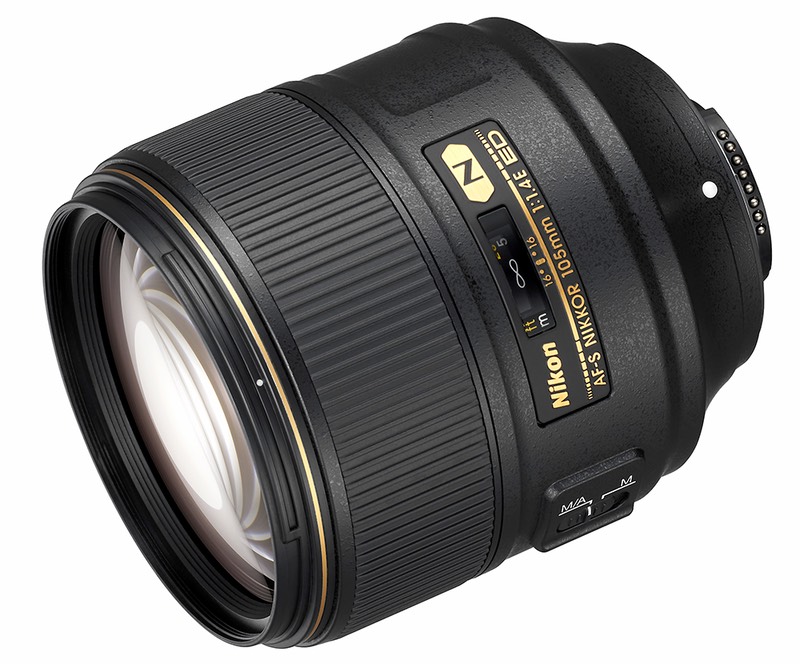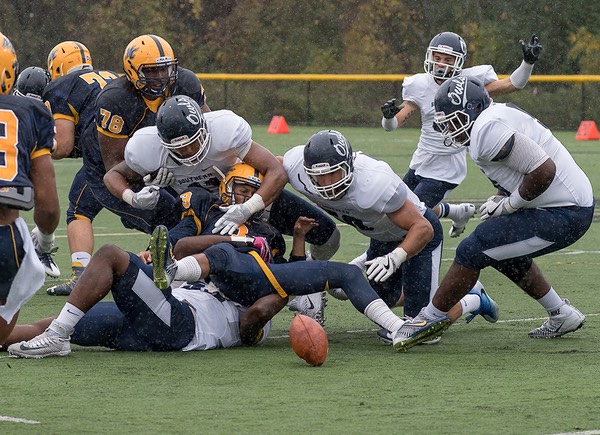
What is It?
The 105mm f/1.4E is something entirely new, which we don’t see much any more with lenses. It’s the fastest 105mm lens available (previously Nikon had a 105mm f/2D, which was as fast as you’d find in this focal length). Getting an extra stop with a new lens is always intriguing. The question everyone had was whether this also meant giving up sharpness (foreshadowing: no).
The new 105mm is an E lens with AF-S. The lens it replaces is a D lens (aperture ring) with no in-lens focus motor. This is a big leap. Coupled with the change from f/2 to f/1.4 and the loss of DC (defocus control), these are all big changes. But there are more.
The new 105mm has Nano and Flourine coating, plus ED elements (the older lens had none of this). The new lens has a regular bayonet lens hood instead of the pull-out one the older lens had.
Weight has grown to 34.8 ounces (945g), about a 50% increase. The new lens is slightly shorter than the older one, but has a bigger diameter at the focus ring. So much so that it takes an 82mm filter (old: 72mm).
The 105mm f/1.4E has a large focus ring out front, the usual M/A and M switch that AF-S lenses tend to have, and a focus indicator with DOF markings at f/16. Focus markings are:
- Feet: 20, 10, 5. 3.5
- Meters: 5, 3, 2, 1.5, 1.2, 1
Closest focus is 3.3 feet (1m), and the focus ring goes from close focus to infinity in just under a half turn.
Nikon includes an HB-79 hood and CL-1218 soft case with the lens, which sells for US$2200. The lens is made in China.
Remember, because this is an E-type lens, it means it is fully compatible only with the: D3 series, D4 series, D5, Df, D3100+, D5xxx, D7xxx, D300 series, D500, D600/D610, D700, D750, and D8xx series (as well as the Nikon 1 cameras with FT-1).
Nikon’s Web page for the 105mm f/1.4 lens.
This review was written with observations based on one purchased sample.
How’s it Handle?
As primes go, the 105mm f/1.4E is a big and heavy lens (34.8 ounces, or almost two pounds [965g]). Obviously, on the consumer DX DSLRs this is going to create a front-heavy situation. On the bigger and pro bodies, it’s well balanced, though, particularly the D4/D5 type body.
If you’re used to the old 105mm f/2D DC, you’re talking about 50% more weight and a bit more diameter.
Indeed, it’s the diameter that’s probably my only comment about the handling for this lens. I found that on my D5 I tended to end up holding the lens right where it slopes back to the lens mount diameter. That’s fine, though the sloped area isn’t quite wide enough to fit my fingers without them bracing against the body. One thing I noticed with some bodies is that I had to be a little careful about that, as I was wedging my fingers into that space and affecting the electrical lens contacts sometimes.
Overall, the lens is a bit short in length, so the weight just isn’t a factor other than carrying fatigue. When shooting your hand is pretty much near the center of gravity no matter where you put it.
How’s it perform?
Focus: I was expecting the usual Nikon prime sluggishness. No such thing here. I used this lens for a lot of sports work when I first received it (see below), and it was very much up to the test of getting focus fast and tracking it perfectly. Of everything about this lens, this was probably the most surprising. I wish all the Nikkor primes were as snappy.
Sharpness: Amazingly, the 105mm f/1.4E is clearly sharper wide open than the older 105mm f/2D DC that it seems to replace. Despite an additional stop of aperture. Strangely, the 105mm f/1.4 seems to be superb at f/1.4, somewhat worse (in the corners) at f/2 to f/4, then back to superb from f/5.6 on. The 105mm f/1.4E is just clearly sharper than the older 105mm f/2 DC lens, and on any test.
The entire frame is very sharp even at f/1.4. Strangely, the corners get less sharp at f/2, then everything returns to very sharp by f/5.6. f/1.4 and f/5.6 are the two sharpest apertures, though no aperture is what I’d call problematic. As you move outwards, the DX area is always excellent, though at f/2 the corners will be clearly less sharp than the central area (fixed by f/4). The far FX corners are never terrible, and I’d consider them “good” at f/2 and f/2.8 and excellent or better everywhere else.
Be careful at longer focus distances: there’s a little field curvature to the lens at the edges, which you’ll need to use a smaller aperture to reign in. This is different than the older DC lens, which didn’t have field curvature. While there’s a bit of astigmatism in the very corners, there’s little coma (though there’s some). I was actually impressed with this, and when I get to bokeh you’ll see why.


Is this lens “Otus sharp”? Well, maybe, but the more interesting thing is that the Otus produces less chromatic aberration. That said, latitudinal chromatic aberration is pretty reasonable, and fully corrected by in-camera routines for JPEGs.
Other: As you’d expect from a very fast prime, there’s clear longitudinal chromatic aberration (purple near, green away). Curiously, the near portion of that aberration seems more intense than the far, an asymmetry I generally don’t find.
Vignetting isn’t as bad as you’d expect. A bit less than a stop at f/1.4, already under a half stop by f/2.5, and fairly ignorable from f/2.8 onward.
Linear distortion is low, less than 0.25%. I’d tend to ignore it. The distortion isn’t regular, by the way. It’s a very minor mustache (central barrel, corners pincushion).
Flare seemed well controlled if the light is out of frame, a little less so with light in the corners of the frame. You might not see this wide open at first, as the flare is softened and spread, but if you stop down far enough you’ll see clear reflection artifacts, which is a bit surprising.
In terms of bokeh, Nikon pretty much nailed it if you like a smooth, neutral bokeh. There’s no onion-ringing (only a faint edge outline), the circles in the center of the frame are very round, and longitudinal chromatic aberration is present, but very modest (note my comment about asymmetry, above). Nikon engineers lately have been talking about rendering the transition from focus plane to out-of-focus more naturally and more smoothly, and the 105mm f/1.4E definitely exhibits this.
Measured focal length: 101mm at infinity.
Personally, I had picked the 135mm f/2D DC over the 105mm for my lens kit, but was never 100% satisfied with it’s out-of-focus rolloff. The 105mm f/1.4E is clearly better, and will now replace it (though I wish for a 135mm version).
Final Words
This is a very sharp lens, even wide open, and especially so for its other attributes (fastest 105mm telephoto to date). Indeed, it’s a lens very free of most troublesome issues, and it’s a clear step forward over the 105mm f/2D DC in my mind. If you’re going for soft transition to out-of-focus, the 105mm f/1.4E is a tough lens to top. Indeed, I like this new lens better than the 85mm f/1.4G, which I sold recently. Granted, 85mm and 105mm are different perspectives in head-and-shoulders portraiture, but I’ll take the slight change in perspective to get the benefits of this new lens.
That said, this is a big, heavy lens and it doesn’t have VR. You need to make sure you can keep your shutter speeds up and stabilize the lens. Failure to do that and it doesn’t matter how sharp it is or how good the focus transitions are, you’ll have mush at the pixel level.
It’s also an expensive lens. Which got me to thinking who would use this lens. Obviously portraits and events. But who else? Well, surprisingly, some sports if the focal length is right. I shot ice hockey with this lens and was more than pleased with the results. The f/1.4 gave me fast shutter speeds but didn’t sacrifice sharpness at all.
And that’s where we get to the real verdict on the 105mm f/1.4E: this is a great lens, just not for everyone. If you need it, don’t be afraid to try it, I think you’ll be extremely happy with the results you generate from it. But if fast 105mm isn’t something you need much or isn’t in your wheelhouse, then admire it from afar and keep shooting with what you’ve got.
Highly Recommended (2017 to present)
Support this site by purchasing from the following advertiser:
